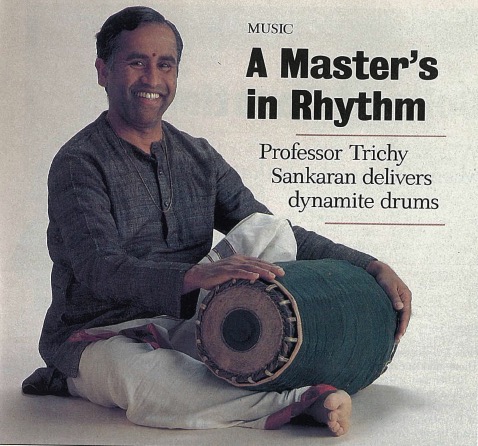By RADHIKA SRINIVASAN, New Jersey
Few percussionists venture from the orchestra into the limelight, and fewer stay for long. But Prof. Trichy Sankaran, the mridangam maestro who heads the Indian Music Studies at York University, Ontario, is a multi-faceted exception. With the dexterity of a craftsman and the wisdom of a philosopher, Sankaran has elevated the mridangam, South Indian barrel drum, to the rare position of a solo instrument. You may have heard his facile fingers fly on HMV recordings from the 1960s, behind such stalwarts as T.R. Mahalingam, Emani Sankara Sastry or S. Balachander. But in three compact disc releases on the Music of the World label, the spotlight shines on him–and he doesn’t blink.
For Sankaran, who was born a Hindu in Poovalur, just outside of Trichanapoli, Hinduism is inseparable from his music. “The rhythms that I play are a reflection of my culture and beliefs. The instrument itself has religious significance. The mridangam is supposed to have been played by Lord Ganesha, and the rhythms are of Lord Siva–He gives the rhythm to the universe. The five basic sounds of the mridangam: tha, dhi, thom, nam and jem, have come from the five faces of Siva–Isana, Tatpurusha, Aghora, Vamadeva and Sadyojata.”
While steeped in tradition, Trichy has been taught by his exposure to the world’s music to think in contemporary ways. Between concerts in Chennai and classes in Toronto, he also composes music for gamelan, Indonesian orchestra, and he experiments in Jazz and Western classical traditions. He has performed with such Jazz greats as Charlie Haden, Anthony Braxton and Dave Brubeck. When asked what led him to the gamelan, Sankaran reminisced, “I went to Bali in 1982 to study the spread of Hindu culture in Java and Bali. I was so intrigued by their music, which is also percussive, that I composed Swara-Laya for the Evergreen Club Gamelan Ensemble of Toronto, which involved tuning my instrument to the pitches and scales of the gamelan.”
For Sankaran, cross-cultural excursions stem from an understanding of other traditions rather than a penchant for stylized hybrids. He notes, “In India, there are some who mix a few instruments together and call it ‘Karnatak jazz’ without knowing exactly how jazz works or even its history. That’s not right. People here simply laugh.” When asked if, with his ventures into other musical styles, he is still committed to pure mridangam tradition, he beat back at once, “Of course. That’s my music, and that’s my God.”
Trichy considers the Shankaracharya of Kanchi Peedam to be his spiritual guru. He confided, “I have had the blessings of the Sankaracharya on many, many occasions. Whenever I go to India, I try to visit him in Kanchipuram.” Trichy labels himself a “true-blue Brahmin” and a “strict vegetarian.” He said, “I worship Siva and Vishnu and perform Ram nam japa (repetition of Rama’s name) morning and evening.” During his prayers, when the music moves him, he may perform for the Gods. He explains, “I worship through my instrument and through my music. That is the most pleasurable thing for me–to play for the divine beauty of it.”
HEARING IS BELIEVING
Laya-Vinyas (rhythmic elaboration), Sankaran’s first CD with Music of the World, is a delightful display of dazzling drum wizardry. Only two short tracks include melodies played on the vina. Sankaran recalls, “I found it very fulfilling, especially the piece where my mridangam, kanjira (frame drum) and konnakol (voice) were super-imposed using over-dubbing.” Laya complements Sankaran’s hands-on manual, Rhythmic Principles and Practice of South Indian Drumming (Lalith Publishers) and comes as a prelude to his instructional video.
The second disc, Sunada (pure sound), contains a traditional ensemble spiritually empowered throughout with the sublime sounds of the vina, played with aplomb by Karaikudi Subramaniam. Yet in terms of both aesthetics, energy and devotional beauty, the newest release, Lotus Signatures, surpasses all else. The mellifluous expression of Dr. N. Ramani, the phenomenal South-Indian flautist, is matched and magnified by the flawless textural finesse of Sankaran. Delectable cross-rhythmic segments heighten the devotional songs, as Sankaran deftly shows how subtle and measured treatment on the mridangam can embellish and empower a melody. A superb studio recording, Lotus develops into a virtual concert, including a glorious rendition of the raga Kiravani. The alternating solos of the percussion ensemble give a fitting finale to the realm of improvisation that this recording soars into.
Lalith Publishers, 31 Manadon Drive, North York, Ontario m2m1w8 Canada * Music of the World, P.O. Box 3620, Chapel Hill, North Carolina 27515 usa


